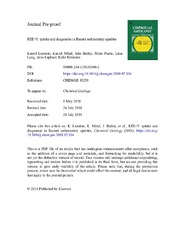REE+Y uptake and diagenesis in Recent sedimentary apatites
Permanent lenke
https://hdl.handle.net/10037/19270Dato
2019-07-30Type
Journal articleTidsskriftartikkel
Peer reviewed
Forfatter
Lumiste, Kaarel; Mänd, Kaarel; Bailey, Juke; Paiste, Päärn; Lang, Liisa; Lepland, Aivo; Kirsimäe, KalleSammendrag
Rare Earth Elements and Yttrium (REE+Y) distribution in authigenic phases are frequently used as proxies for reconstructing past seawater conditions. Sedimentary apatite precipitates near the sediment-water interface and is therefore capable of recording the REE+Y composition of the overlying water column. While the overprinting of primary REE+Y signal during late stage diagenesis is a widely known phenomenon, less is known about early diagenetic effects. In this study, we investigate the REE+Y distribution in Recent sedimentary apatites found on the Namibian shelf using in situ mapping by laser ablation inductively coupled plasma mass spectrometry (LA-ICP-MS). The Namibian phosphorite deposits consist of reworked and redeposited pelletal apatitic grains, ranging from Miocene to Pleistocene in age, and pristine concretionary apatitic grains that formed during Pleistocene to Recent. The results of this study show that the REE+Y signatures of pelletal and concretionary apatitic grains are different with both types showing intragranular variability and differences between grain centers and rims. The REE+Y are concentrated in the external part of the apatitic grains, forming a 10–20 μm wide “enrichment zone”. While the central parts of apatitic grains are low in REE+Y (∑REE+Y < 450 mg/kg), the external layers can reach ∑REE+Y concentrations as high as 4100 mg/kg. REE+Y patterns from the center of Recent concretionary apatitic grains are similar to the REE+Y distribution of modern seawater. Enriched rims of Recent concretionary apatitic grains as well as pelletal grains have lost the characteristic modern seawater features: negative Ce-anomaly and high Y/Ho ratio. The REE+Y patterns of these enrichment zones indicate REE+Y scavenging from suboxic-sulfidic pore water after burial or during precipitation at the fluctuating redoxcline. It is evident that REE+Y patterns in bulk digests of authigenic apatite cannot be relied on to record paleoseawater characteristics. Micro-scale REE+Y analyses of apatitic grains can, however, reveal aspects of their diagenetic histories.
Forlag
ElsevierSitering
Lumiste, Mänd, Bailey, Paiste, Lang, Lepland, Kirsimäe. REE+Y uptake and diagenesis in Recent sedimentary apatites. Chemical Geology. 2019;525:268-281Metadata
Vis full innførselSamlinger
Copyright 2019 Elsevier B.V.


 English
English norsk
norsk